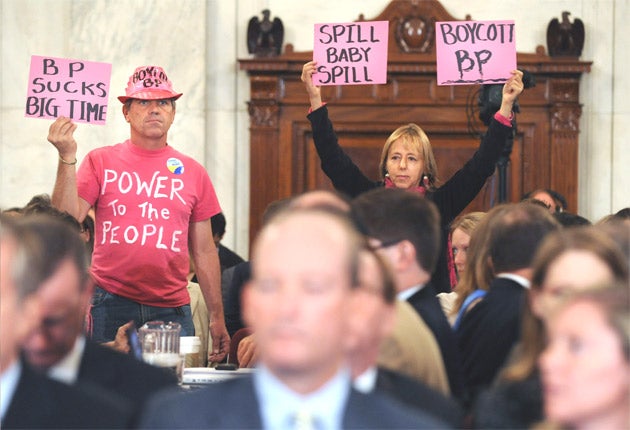Patience on Capitol Hill runs dry as firms try to shift blame for oil leak

Your support helps us to tell the story
From reproductive rights to climate change to Big Tech, The Independent is on the ground when the story is developing. Whether it's investigating the financials of Elon Musk's pro-Trump PAC or producing our latest documentary, 'The A Word', which shines a light on the American women fighting for reproductive rights, we know how important it is to parse out the facts from the messaging.
At such a critical moment in US history, we need reporters on the ground. Your donation allows us to keep sending journalists to speak to both sides of the story.
The Independent is trusted by Americans across the entire political spectrum. And unlike many other quality news outlets, we choose not to lock Americans out of our reporting and analysis with paywalls. We believe quality journalism should be available to everyone, paid for by those who can afford it.
Your support makes all the difference.Top executives from BP and two other companies involved in the rig that exploded in the Gulf of Mexico last month were chastised repeatedly yesterday at a key US Senate hearing for attempting at the outset to shift blame for the disaster to one another.
The fractious exchanges took place as Lamar McKay, the chairman of BP America, alongside counterparts from Transocean, the owner and operator of the destroyed rig, and Halliburton, the giant energy services company, underwent sharp questioning by members of the Senate Energy and Natural Resources Committee.
Opening the hearing, the committee chairman, Senator Jeff Bingaman, a Democrat, suggested the accident was due to "a cascade of errors, technical, human and regulatory", and compared it to past great disasters in history including the sinking of the Titanic and the Three-Mile Island nuclear power plant meltdown.
Mr McKay repeated that BP would "carry out its responsibilities" in getting the well under control and in the clean-up. But, as expected, he pointed also to Transocean's blow-out preventer, a series of shut-off valves on the sea floor, that was supposed to close the well down in the event of a catastrophic failure but did not.
For his part, Steven Newman, the chief safety officer of Transocean, sought to emphasise the final responsibility of BP as the client that leased the rig. "Offshore oil and gas production projects begin and end with the operator, in this case BP," he said. He speculated that the blow-out preventer may have been disabled by debris.
Transocean also attempted to direct the attention of the senators to problems associated with Halliburton's main task, which was to plug the newly-drilled well with cement to allow it to be abandoned until such time as BP was ready to return and begin drawing off oil. For some time now, suspicions have grown that this cementing process may have been at the core of the massive blow-out that occurred on 20 April.
"I hear one message: 'Don't blame me'," grumbled Senator John Barrasso, a Republican from Wyoming. "Shifting the blame game doesn't get us very far." One after another, senators from both parties emphasised that the future of offshore drilling in America depended on getting to the bottom of what went wrong with this well.
"I would suggest to all three of you that we are all in this together," scolded Senator Lisa Murkowsky. "If we can't continue to operate and convince people we can perform safely, not only will BP not be out there but Transocean won't be out there to provide the rigs and Halliburton won't be out there to perform the cementing."
BP is braced for what will be weeks of intensive hearings into the accident which, aside from setting off a huge environmental crisis, cost the lives of eleven workers. They will be conducted by committees of the US Senate and the House of Representatives in Washington, DC. A separate US government inquiry is to get under way in Kenner, Louisiana, this morning.
An attempt by BP last week to lower a large containment dome over the leak 5,000 (1,5km) feet beneath the ocean surface was unsuccessful. The company is now proposing to put a smaller "top hat" in place to capture some leaking oil. That, too, promises to be tricky. Meanwhile, oil continues to spill from pipes at the seabed at an estimate rate of 210,000 gallons a day.
Senators last night asked BP and the other executives to explain why so-called "mud" had been removed from the riser pipe between the well head itself and the rig, and replaced with much lighter sea water before the final cement plug was set. "I am not familiar with the individual procedures [of] that well," Mr McKay said.
Prodded on how much of the response BP is ready to pay for, Mr McKay said: "We have been very clear... we are going to pay all legitimate claims, substantiated clams. The intent is to be fair, responsible and expeditious." This week, the company said it had already spent $350m (£234m) on the spill, including hiring fishermen to help contain it.
That the "mud" in the riser was replaced before the final plug was set was confirmed at the Senate hearing by Tim Probert, a Halliburton executive. When all the cementing was completed, the usual tests were undertaken, he said. The blow-out of oil and gas, hurtling up the pipe and exploding after igniting, occurred 20 hours after Halliburton finished its work.
Join our commenting forum
Join thought-provoking conversations, follow other Independent readers and see their replies
Comments